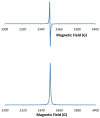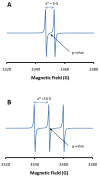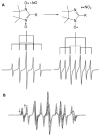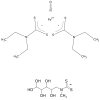Detection of nitric oxide by electron paramagnetic resonance spectroscopy
- PMID: 20304044
- PMCID: PMC2916063
- DOI: 10.1016/j.freeradbiomed.2010.03.009
Detection of nitric oxide by electron paramagnetic resonance spectroscopy
Abstract
Electron paramagnetic resonance (EPR) spectroscopy has been used in a number of ways to study nitric oxide chemistry and biology. As an intrinsically stable and relatively unreactive diatomic free radical, the challenges of detecting this species by EPR are somewhat different from those of transient radical species. This review gives a basic introduction to EPR spectroscopy and discusses its uses to assess and quantify nitric oxide formation in biological systems.
Copyright 2010 Elsevier Inc. All rights reserved.
Figures






Similar articles
-
Detection and characterisation of radicals using electron paramagnetic resonance (EPR) spin trapping and related methods.Methods. 2016 Oct 15;109:21-30. doi: 10.1016/j.ymeth.2016.05.013. Epub 2016 May 19. Methods. 2016. PMID: 27211009 Review.
-
Detection of Nitric Oxide by Electron Paramagnetic Resonance Spectroscopy: Spin-Trapping with Iron-Dithiocarbamates.Methods Mol Biol. 2016;1424:81-102. doi: 10.1007/978-1-4939-3600-7_8. Methods Mol Biol. 2016. PMID: 27094413
-
Detection and characterisation of radicals in biological materials using EPR methodology.Biochim Biophys Acta. 2014 Feb;1840(2):708-21. doi: 10.1016/j.bbagen.2013.03.034. Epub 2013 Apr 6. Biochim Biophys Acta. 2014. PMID: 23567797 Review.
-
Detection of bioradicals by in vivo L-band electron spin resonance spectrometry.NMR Biomed. 2004 Aug;17(5):311-8. doi: 10.1002/nbm.898. NMR Biomed. 2004. PMID: 15366030 Review.
-
Identification and quantification of free radicals during myocardial ischemia and reperfusion using electron paramagnetic resonance spectroscopy.Arch Biochem Biophys. 2003 Dec 15;420(2):209-16. doi: 10.1016/j.abb.2003.07.007. Arch Biochem Biophys. 2003. PMID: 14654059 Review.
Cited by
-
H2S regulation of nitric oxide metabolism.Methods Enzymol. 2015;554:271-97. doi: 10.1016/bs.mie.2014.11.040. Epub 2015 Jan 17. Methods Enzymol. 2015. PMID: 25725527 Free PMC article.
-
The nitric oxide production in the moss Physcomitrella patens is mediated by nitrate reductase.PLoS One. 2015 Mar 5;10(3):e0119400. doi: 10.1371/journal.pone.0119400. eCollection 2015. PLoS One. 2015. PMID: 25742644 Free PMC article.
-
Investigation of NO Role in Neural Tissue in Brain and Spinal Cord Injury.Molecules. 2023 Oct 31;28(21):7359. doi: 10.3390/molecules28217359. Molecules. 2023. PMID: 37959778 Free PMC article.
-
Can metal ion complexes be used as polarizing agents for solution DNP? A theoretical discussion.J Biomol NMR. 2014 Apr;58(4):239-49. doi: 10.1007/s10858-013-9728-8. Epub 2013 Apr 20. J Biomol NMR. 2014. PMID: 23606273
-
Unveiling Mechanistic Insights and Photocatalytic Advancements in Intramolecular Photo-(3 + 2)-Cycloaddition: A Comparative Assessment of Two Paradigmatic Single-Electron-Transfer Models.JACS Au. 2023 Dec 14;4(2):419-431. doi: 10.1021/jacsau.3c00542. eCollection 2024 Feb 26. JACS Au. 2023. PMID: 38425917 Free PMC article.
References
-
- Duling DR. Simulation of multiple isotropic spin-trap EPR spectra. J Magn Res B. 1994;104:105–110. - PubMed
-
- Knowles PF, March D, Rattle HWE. Magnetic Resonance of Biomolecules. New Jersey: John Wiley and Sons; 1976.
-
- Weil JA, Bolton JR. Electron Paramagnetic Resonance Elementary Theory and Practical Applications. New Jersey: John Wiley and Sons; 2007.
-
- Uehara H, Arimitsu S. Gas-phase electron paramagnetic resonance detection of ntiric oxide and nitrogen dioxide in pulluted air. Anal Chem. 1973;45:1897–1900. - PubMed
-
- Villamena FA, Zweier JL. Detection of Reactive Oxygen and Nitrogen Species by EPR Spin Trapping. Antioxidants & Redox Signaling. 2004;6:619–629. - PubMed
Publication types
MeSH terms
Substances
Grants and funding
LinkOut - more resources
Full Text Sources
Other Literature Sources
Research Materials

